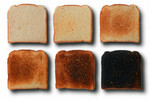
Published in the LWT – Food Science and Technology journal, Brazilian researchers studied the impact of three fibres – wheat bran, resistant starch and locust bean gum – on the quality and processing of pan bread.
High-speed mixing time, proofing time, bread volume and crumb colour and moisture were the parameters analysed.
“In general, literature has reported various detrimental effects on dough handling and bread quality associated with flour replacement by dietary fibre, such as wheat bran and resistant starch,” the researchers said.
Findings in this study showed that overall, bread volume and high-speed mixing time was influenced by fibres but proofing time and taste was not.
Wheat bran and locust bean gum impacted most of the parameters evaluated.
“Wheat bran was the only fibre source that influenced specific volume,”researchers said, but “high-speed mixing time, crumb colour acceptance, crumb appearance acceptance and texture acceptance were influenced by the three different fibre sources studied”.
A fibre choice
In addition to reducing bread volume, wheat bran was found to reduce crumb luminosity and increase high-speed mixing time, crumb chroma and crumb moisture content.
Locust bean gum also reduced crumb luminosity and increased crumb moisture content, but reduced high-speed mixing time.
Resistant starch increased high-speed mixing time, but was a more ‘inert’ fibre source in relation to bread quality characteristics, the researchers said, presenting interaction effects with the other fibre sources present in the system.
“Knowing this, fibres can be used by the food technologist in bread formulations, alone or combined, to obtain desired properties such as the increase of dietary fibre content and the maintenance of freshness during shelf-life, or manipulate process parameters such as mixing time,” they said.
Formulations used were 0-20g wheat bran/100g flour, 0-20g resistant starch/100g flour and 0-3g locust bean gum/100g flour.
Consumer appeal
Researchers found that consumers purchasing fibre-enriched bread expected to see bran particles, therefore the addition of more than 10g of wheat bran to each 100g of flour “yielded good results in the sensory evaluation of crumb colour and appearance”.
A recently published science paper suggested that there is a wealth of on-going industry challenges with fibre-rich baked good formulations – one being low consumer acceptance.





